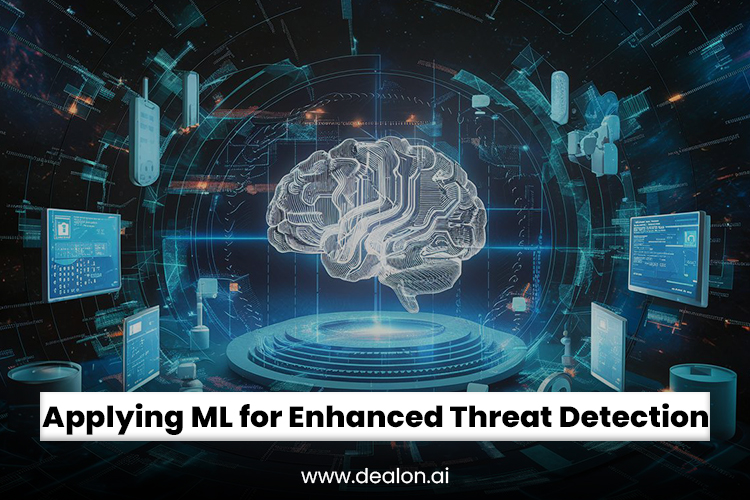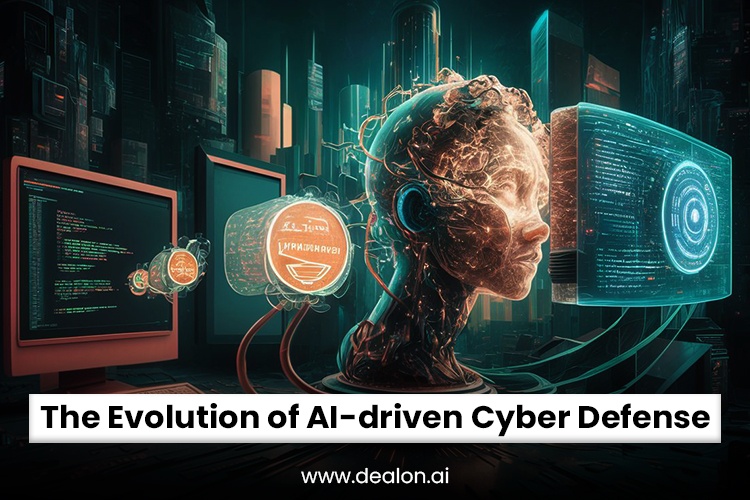In an age dominated by digital connectivity, the specter of cyber threats looms large, casting a shadow over the security of our digital assets. Cybersecurity, defending networks, systems, and data from malicious attacks, has become a cornerstone of modern business operations. However, as cybercriminals continue to innovate and exploit vulnerabilities, traditional cybersecurity measures are no longer sufficient to ward off sophisticated threats.
Enter Artificial Intelligence (AI) and Machine Learning (ML), two transformative technologies reshaping the landscape. AI can mimic human intelligence and adapt to changing environments, and it holds immense promise for fortifying digital defenses against evolving threats. ML, a subset of AI, empowers systems to understand data, identify patterns, and make better decisions without explicit programming, enhancing threat detection and response capabilities.
In this era of relentless cyber warfare, the marriage of AI and cybersecurity offers hope for organizations striving to safeguard their digital assets. By harnessing the power of AI and ML, cybersecurity professionals can analyze vast troves of data in real time, identify anomalies indicative of malicious activity, and proactively mitigate threats before they escalate. From detecting sophisticated malware and phishing attempts to thwarting insider threats, AI-driven solutions offer a proactive defense mechanism against many cyber threats.
Furthermore, the evolution of AI-driven cyber defense extends beyond threat detection to encompass predictive analytics, autonomous threat mitigation, and risk management. With AI as a force multiplier, organizations can stay one step ahead of cyber adversaries, bolstering their resilience in the face of relentless attacks.
This introductory exploration delves into the symbiotic relationship between AI and cybersecurity. We explore how these technologies converge to fortify digital defenses and defend against the ever-evolving cyber threat landscape. Join us as we unravel the intricacies of AI-driven cybersecurity and navigate the path toward a secure digital future.
Understanding Cybersecurity in the Digital Age

In the digital age, cybersecurity stands as the bulwark against an ever-expanding array of threats poised to exploit vulnerabilities in networks, systems, and data repositories. At its core, it encompasses an intricate tapestry of practices, technologies, and processes meticulously crafted to safeguard digital assets from unauthorized access, breaches, and malicious attacks. With the rapid proliferation of digital technologies and the across-the-board adoption of cloud computing, mobile devices, and Internet of Things (IoT) devices, organizations navigate an increasingly complex threat landscape.
The advent of remote work arrangements further compounds these challenges, widening the attack surface and exposing sensitive data to new vulnerabilities. From multinational corporations to small businesses, no entity is immune to the perils of cyber threats. Financial institutions contend with cybercriminals seeking to exploit weaknesses in their digital infrastructure for monetary gain, while healthcare providers confront the specter of ransomware attacks jeopardizing patient care and confidentiality.
Moreover, government agencies, educational institutions, and critical infrastructure sectors face persistent cyber threats with far-reaching implications for national security and public safety. Against this backdrop, robust measures emerge as essential for organizations that protect their digital assets, preserve trust with stakeholders, and uphold regulatory compliance.
By implementing a multi-layered approach encompassing proactive threat detection, robust access controls, encryption, and incident response protocols, businesses can mitigate the risks posed by cyber adversaries and fortify their resilience in an increasingly interconnected world. Cybersecurity transcends mere technological prowess; it embodies a strategic imperative for organizations striving to thrive in the digital frontier while safeguarding their most precious assets’ integrity, confidentiality, and availability.
Also Read: 10 Industries Being Disrupted by AI Technology: Revolutionizing the Landscape
The Role of AI in Cybersecurity
The rise of Artificial Intelligence as a game-changer in cybersecurity marks a paradigm shift in the battle against evolving cyber threats. Traditional approaches, relying on predefined rules and signatures, struggle to keep pace with the dynamic tactics of cybercriminals. AI introduces a transformative approach in this arms race between defenders and adversaries, offering dynamic and adaptive solutions to counter sophisticated threats.
At the heart of AI-powered cybersecurity lies machine learning (ML), a subset of AI that enables systems to understand data, identify patterns, and make decisions without explicit programming. By leveraging ML algorithms, AI-powered cybersecurity systems can analyze vast troves of data in real-time, discerning subtle anomalies indicative of malicious activity amidst digital noise. Unlike static defenses, which may falter in the face of evolving threats, AI algorithms continuously evolve and adapt, learning from new data and experiences to enhance their detection capabilities.
One of the fundamental advantages of AI in cybersecurity is its ability to detect previously unseen threats with greater accuracy and efficiency. Traditional signature-based approaches excel at identifying known threats but falter when confronted with novel or zero-day attacks. Conversely, AI operates on the anomaly detection principle, identifying deviations from standard behavior patterns that may signify a potential security incident. From detecting malware and phishing attempts to identifying insider threats, AI empowers organizations to stay one step ahead of cyber adversaries by proactively identifying and mitigating emerging threats before they inflict harm.
Moreover, AI-driven cybersecurity solutions offer scalability and automation unmatched by traditional approaches. By automating routine errands such as threat detection, analysis, and response, AI augments the capabilities of cybersecurity professionals, enabling them to focus their expertise on strategic initiatives and high-priority threats. This improves operational efficiency and accelerates incident response times, reducing the window of opportunity for cyber attackers to exploit vulnerabilities.
The role of AI in cybersecurity is transformative, offering dynamic, adaptive, and scalable solutions to combat the ever-evolving threat landscape. By utilizing the strength of AI and machine learning, organizations can fortify their defenses, detect and mitigate threats in real time, and safeguard their digital assets from cyber adversaries. As the cyber threat landscape persists to transform, AI-driven cybersecurity remains an indispensable ally in the ongoing battle for digital resilience and security.
Applying ML for Enhanced Threat Detection

Machine Learning (ML) stands as a cornerstone in the arsenal of cybersecurity professionals, offering a dynamic and proactive approach to threat detection and mitigation. Unlike traditional methods, which rely heavily on static rules and signatures, ML algorithms can analyze diverse datasets with remarkable precision, enabling organizations to maintain an edge over evolving cyber threats. ML algorithms excel at sifting through vast amounts of data, ranging from network traffic logs to user behavior patterns and system logs.
By discerning patterns and anomalies within this data, ML algorithms can identify potential security incidents that might go unnoticed. This ability to distinguish normal behavior from suspicious activities enables security teams to flag potential threats for further investigation, allowing for swift and targeted response measures. Furthermore, ML-powered cybersecurity solutions promise automation, streamlining threat detection and response processes to reduce the burden on human analysts.
By automating routine errands such as data analysis and incident triage, ML algorithms enable security teams to focus their expertise on strategic initiatives and high-priority threats. This improves operational efficiency and accelerates incident response times, minimizing the window of opportunity for cyber attackers to inflict harm. The proactive nature of ML-powered cybersecurity solutions is particularly advantageous in today’s fast-paced threat landscape. By identifying and mitigating emerging threats in real-time, organizations can reduce risks and minimize the impact of cyberattacks on their operations and reputation.
Moreover, the continuous learning capabilities of ML algorithms enable these systems to adapt and evolve alongside evolving threat vectors, ensuring a robust defense against known and unknown threats. ML plays a pivotal role in enhancing threat detection capabilities within its frameworks. By utilizing the potential of ML algorithms to analyze diverse datasets and automate threat detection processes, organizations can fortify their defenses, mitigate risks, and maintain cyber resilience in the face of evolving threats. As cyber adversaries continue to innovate and exploit vulnerabilities, ML-powered cybersecurity remains an indispensable ally in the ongoing battle for digital security.
The Evolution of AI-driven Cyber Defense

In the relentless arms race between cyber attackers and defenders, the evolution of AI-driven cyber defense has emerged as a critical imperative. As cyber threats evolve in sophistication and scale, traditional cybersecurity approaches struggle to keep pace, necessitating the adoption of innovative solutions powered by Artificial Intelligence (AI) and Machine Learning (ML). AI-driven cyber defense represents a paradigm shift in its practices, offering proactive and adaptive solutions to combat emerging threats.
By harnessing the power of AI and ML, cybersecurity professionals can analyze vast datasets with unprecedented speed and accuracy, gaining actionable insights into potential vulnerabilities and emerging attack vectors. This proactive approach enables organizations to shore up their defenses preemptively, identifying and mitigating cyber threats before they escalate into full-scale breaches. One of the primary advantages of AI-driven cyber defense lies in its predictive capabilities.
By leveraging predictive analytics, AI algorithms can forecast potential threats based on historical data and emerging trends, allowing organizations to anticipate and prepare for future cyber attacks. This proactive stance enables cybersecurity teams to maintain a proactive stance against cyber adversaries, fortifying their defenses and minimizing the risk of successful breaches. Moreover, AI-driven cybersecurity solutions offer a holistic approach to safeguarding digital assets and maintaining cyber resilience across the entire threat landscape.
From threat hunting and incident response to risk management and compliance, AI technologies empower organizations to proactively identify, assess, and mitigate cyber risks in real time. By automating mundane tasks and augmenting human decision-making processes, AI-driven cyber defense solutions enhance operational efficiency and effectiveness, enabling organizations to respond swiftly and effectively to cyber threats. The evolution of AI-driven cyber defense represents a fundamental shift in cybersecurity paradigms, allowing organizations to build resilient defenses against evolving threats.
By harnessing the power of AI and ML, cybersecurity professionals can gain actionable insights, anticipate future threats, and proactively mitigate cyber risks. As cyber threats persist to transform in complexity and scale, AI-driven cyber defense remains an indispensable tool for safeguarding digital assets and maintaining cyber resilience in an increasingly hostile cyber landscape.
Emerging Trends in Cyber Threat Landscape
In today’s interconnected world, the cyber threat landscape is constantly in flux, evolving at a dizzying pace to outsmart even the most robust of defenses. As organizations strive to maintain a proactive stance, it’s essential to delve into the emerging trends shaping the future of cybersecurity. One such trend is the proliferation of ransomware attacks, which have become increasingly sophisticated and pervasive in recent years.
Cybercriminals leverage advanced techniques such as double extortion and ransomware-as-a-service (RaaS) to extort hefty sums from organizations of all sizes. These attacks encrypt critical data and threaten to leak sensitive information, amplifying the financial and reputational damage inflicted on victims.
Another emerging trend is the rise of supply chain attacks, where threat actors target vulnerabilities in third-party vendors or service providers to infiltrate the networks of their primary targets. This tactic has been exemplified by high-profile breaches like the SolarWinds incident, where attackers compromised a trusted software provider to gain access to numerous government and corporate networks. As organizations increasingly rely on interconnected ecosystems of suppliers and partners, securing the supply chain has become a paramount concern.
Furthermore, the expansion of Internet of Things (IoT) devices presents new challenges in cybersecurity. With billions of connected devices entering the market, each representing a potential entry point for cyber attackers, securing IoT ecosystems has become daunting. Vulnerabilities in IoT devices, coupled with lax security practices, create fertile ground for botnets and distributed denial-of-service (DDoS) attacks, amplifying the scale and impact of cyber threats.
To address these emerging challenges, organizations must adopt a proactive and multi-layered approach to cybersecurity. This includes implementing robust threat intelligence programs, conducting regular security assessments, and investing in technologies like AI and machine learning to determine and mitigate threats in real-time.
As the cyber threat landscape persists and transforms, organizations must remain aware and adaptable to stay one step ahead of cyber adversaries. By understanding and responding to emerging trends in cybersecurity, businesses can bolster their defenses and safeguard their digital assets in an increasingly hostile digital environment.
Conclusion
The symbiotic relationship between Artificial Intelligence (AI) and cybersecurity represents a pivotal milestone in the ongoing battle against cyber threats. From enhancing threat detection capabilities to fortifying digital defenses and enabling proactive risk management, AI-driven cybersecurity solutions offer a multifaceted approach to safeguarding digital assets in an ever-evolving threat landscape. The evolution of AI-driven cyber defense signifies a paradigm shift in its practices, empowering organizations to stay ahead of emerging threats and maintain cyber resilience.
By utilizing the strength of AI and Machine Learning (ML), cybersecurity professionals gain actionable insights, anticipate future threats, and proactively mitigate risks, thereby decreasing the likelihood and effect of successful cyber attacks. Exploring emerging trends in the cyber threat landscape reveals challenges such as ransomware attacks, supply chain vulnerabilities, and IoT security concerns, emphasizing the need for proactive cybersecurity measures.
As cyber adversaries continue to innovate and exploit vulnerabilities, adopting AI-driven cybersecurity solutions becomes increasingly imperative. By embracing AI technologies, organizations can confidently navigate the complexities of the digital frontier, knowing that they have the tools and capabilities to defend against evolving cyber threats. In this era of digital innovation and relentless cyber warfare, AI stands as a beacon of hope, offering a proactive and adaptive approach to safeguarding digital assets and ensuring a secure digital future.

